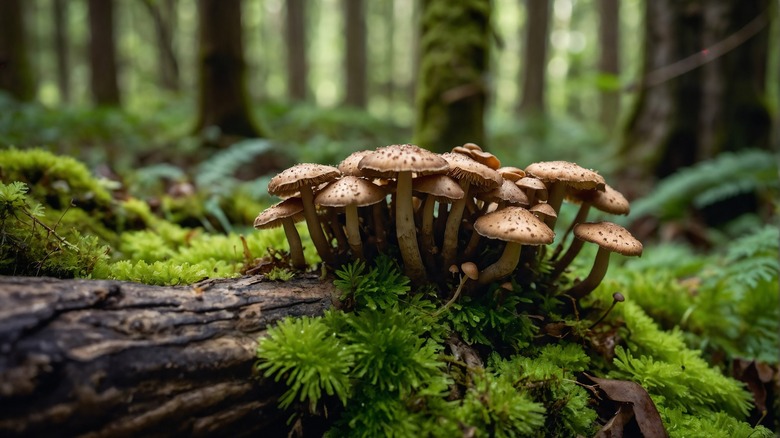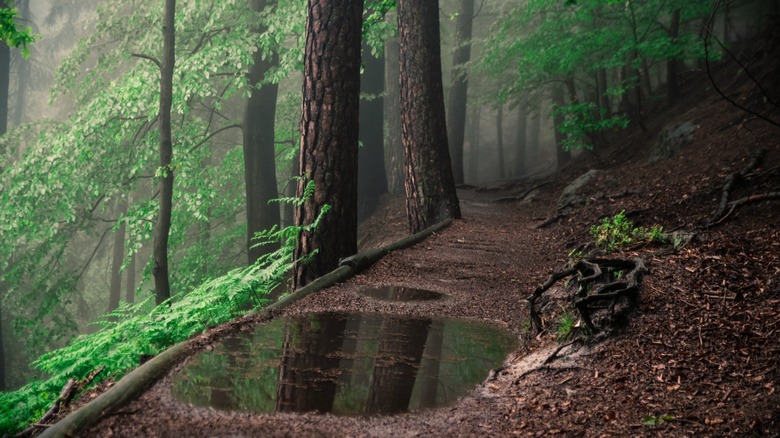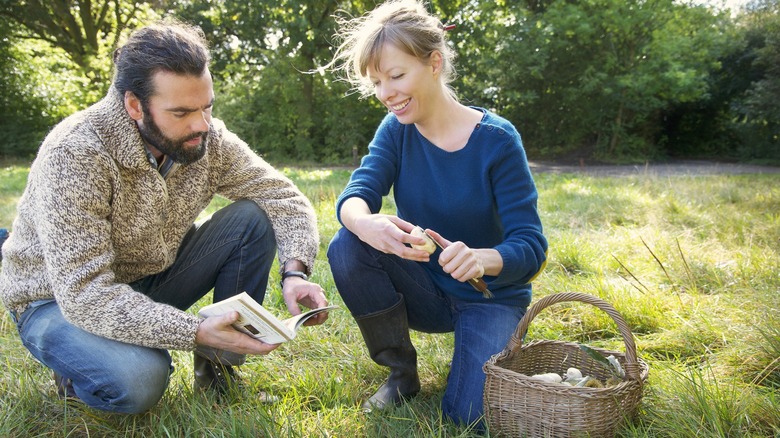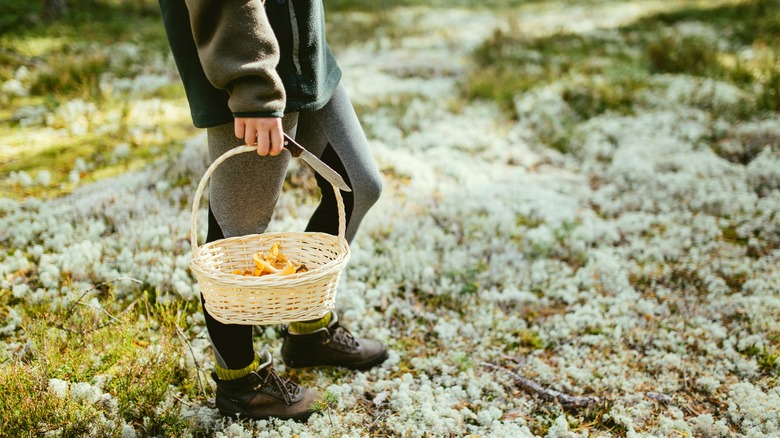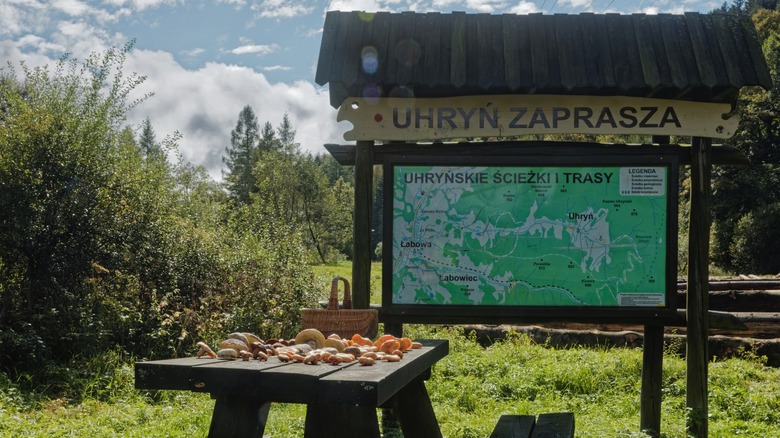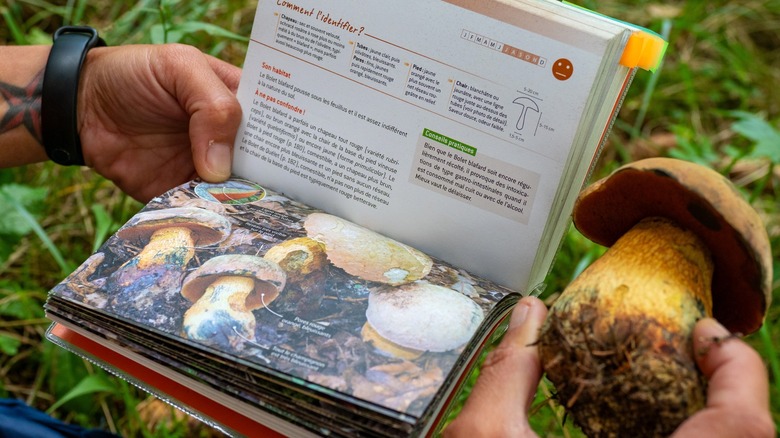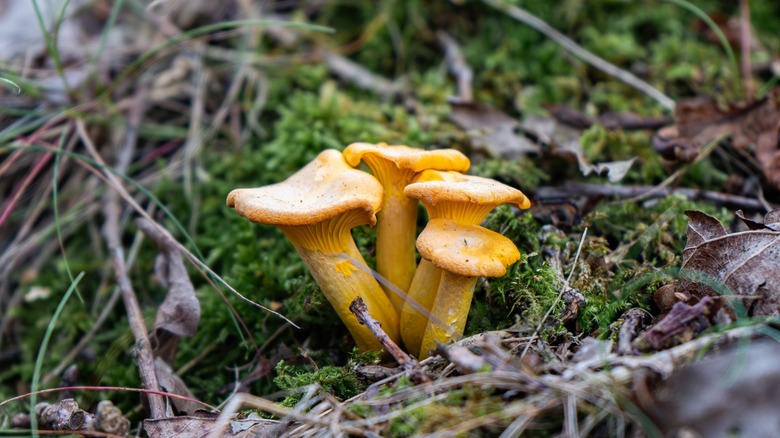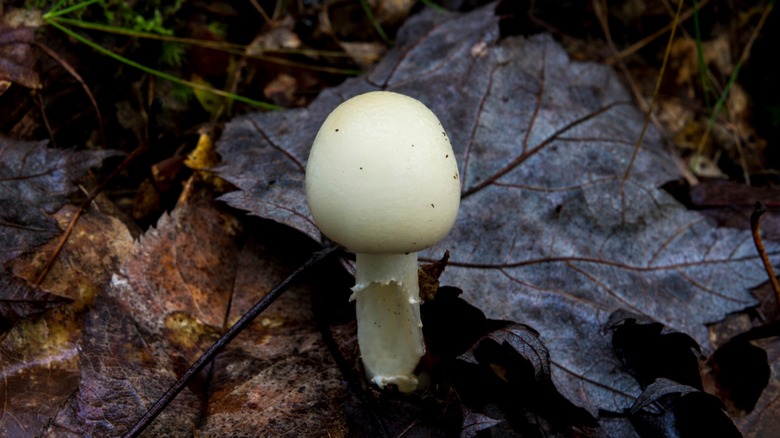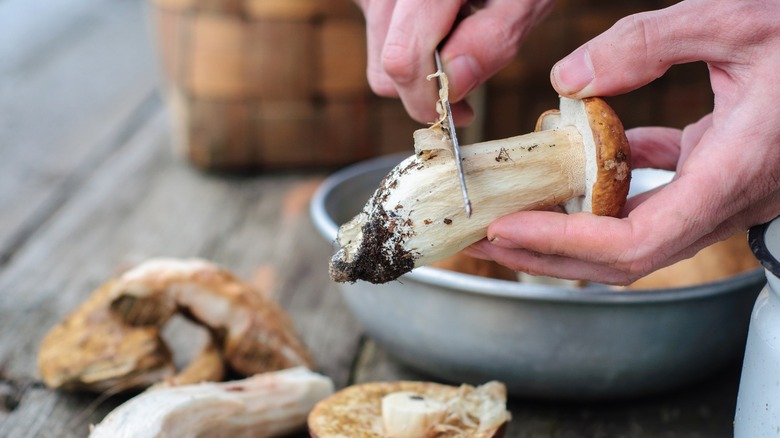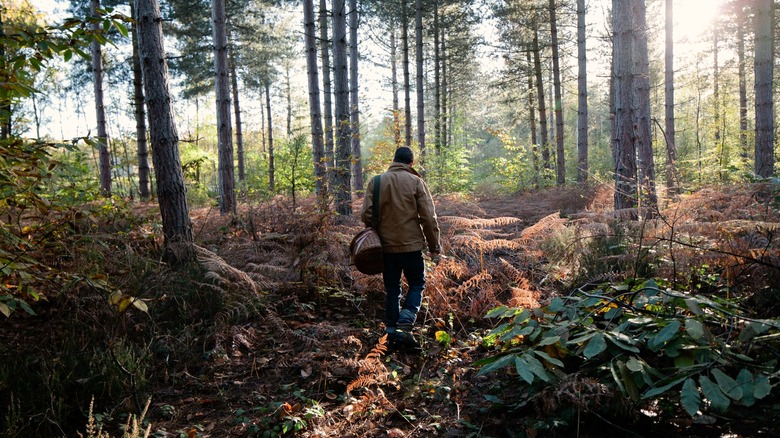10 Tips On Mushroom Foraging From An Expert
Ever dreamed of wandering through a misty forest, basket in hand, in search of nature's hidden edible treasures? Welcome to the thrilling world of mushroom foraging — an adventure that's equal parts exciting and potentially perilous for urban dwellers. Venturing into the woods on a wild mushroom hunt engages our primal instincts and offers a unique opportunity to reconnect with nature. Even if you're a hardcore fan of U.S. top-selling white button mushrooms, you won't be able to resist the exciting treasures harbored by the forest. Imagine stumbling upon a giant puffball, or unearthing other prized edibles, not to mention the pride of serving guests homemade asparagus and morel risotto or lion's mane "crab cakes" featuring your foraged finds!
But this meditative practice also requires knowledge, patience, and a healthy dose of caution — and all the expert help you can get. Enter Matthew E. Smith, Professor of Plant Pathology at the University of Florida, and our guide into this fascinating realm. With his seasoned advice, you'll learn to distinguish between easily recognizable delicacies and their less friendly forest counterparts. From the importance of preliminary research and assembling your foraging kit to proper identifying and storing techniques, this expert guide will equip you with essential know-how for safe and sustainable foraging. Arm yourself with patience, good company, and a few basic tools, and get ready for your first mushroom hunt!
Study your local mushroom species thoroughly
For new foraging enthusiasts, learning restraint is crucial. While the allure of wild adventures may be strong, Professor Matthew E. Smith wisely advises novices "Don't rush the process". He adds, "Just like most people would not go out into the woods and start to eat plants that they do not know, we should do the same for fungi. Once you know them well, only then should you consider foraging for them." So if you want your mushroom hunting missions to succeed, focus on doing your research first. This includes understanding your region's prime foraging spots and local mushroom varieties.
The fungi landscape varies dramatically across regions, with Smith noting, "There is almost no overlap in the fungi species and many of the genera are different." The Pacific Northwest is ideal for beginners, with some of the top U.S. foraging counties located there. The Pacific region is also home to some of the most popular wild-harvested commercial varieties, from golden chanterelles and morels to porcini and lobster mushrooms. However, you can find an abundance of mushrooms in many other regions throughout the year.
Fungi grow in a variety of places, and each environment hosts its own unique species. Smith notes, "Most of the best foraging happens in forests," but mushrooms also grow in grasslands, meadows, wetlands, and on decaying logs. If you live in the urban jungle with no forest in sight, you can still spot mushrooms in parks, lawns, and yes — even along sidewalks! So as long as you set out with a blend of knowledge, patience, and observational skills, you can transform any walk into a foraging mission.
Understand optimal foraging conditions
Now that you've determined the best foraging spots in your area, you'll need to focus your attention on other important factors that play a role in fungal growth, namely, precipitation. "Fungi need water to produce their mushrooms. Therefore, it is important to know your area and the time of year to expect fungi," says Professor Matthew E. Smith. Temperatures also matter: Warmer conditions initially promote spore germination and mycelial growth, while a subsequent temperature drop launches the formation of primordia, the precursors to fruiting bodies. The final fruiting stage requires a precise combination of humidity and temperature, which often happens during the fall. But even though this season often provides ideal conditions for mushroom hunting, especially following heavy rainfall, that doesn't mean you can't forage year-round!
Mushroom seasonality can look different depending on where you're located. As Florida's state mycologist, Professor Smith attests that "much of the year is great for fungi foraging" down there, with the two best months unexpectedly being August and January. The same can be said for the Southeastern states, where you'll find morels appearing in spring, chanterelles and meaty chicken of the woods in summer, and lion's mane and oyster mushrooms in fall and winter. "However," Smith adds, "places with seasonal drought (e.g. where I grew up in California) often have very specific times for foraging." And yet, the Westernmost part of the U.S. still proudly offers nearly year-round availability of certain species like the Black Trumpet and Chanterelle. Certain months, like October and December, show a greater variety of mushrooms available, indicating peak foraging seasons. So to maximize your foraging success, research wild mushroom seasonality specific to your area before venturing into the woods.
Don't venture out alone
For novice foragers, staying safe requires more than preliminary research. It's all about having the right mix of reliable resources when you finally venture out into the wild. The digital age has made these resources readily accessible, just a few clicks away, yet it's the guidance of experienced foragers that proves most invaluable. Professor Matthew E. Smith underscores this point, emphasizing that mastering foraging and identification techniques is best achieved through expert mentorship. Find local foraging tours, walks, groups, and classes in your area — almost every state has one! From The Mushroom Club of Georgia and Maine Mycological Association to Catskill Fungi, there's no shortage of organizations ready to take you under their wing. This can help you get some hands-on experience in a controlled environment while expanding your network of fungi enthusiasts.
Alternatively, Smith recommends making "slow and steady progress with a guidebook or the internet (for checking your photos against known fungi)." Field guides such as David Arora's 'Mushrooms Demystified' are the life-blood of mushroom identification. So if you're looking for detailed descriptions with high-quality photographs and specific habitat information, pick up at least two location-specific field guides to cross-reference on your foraging trips. The digital world expands your options through platforms like iNaturalist and mycological society websites that offer community verification and extra insights. However, Professor Smith cautions against over-reliance on technology: "The iNaturalist interface and other AI tools do not always accurately ID fungi and it can be very dangerous to use them for foraging." Remember: These apps work well for initial screening but should never be your only way to identify specimens.
Equip yourself for foraging
A successful wild mushroom hunt begins with a well-organized foraging kit. Professor Matthew E. Smith emphasizes two essential items: "A good knife and something to collect your mushrooms into," noting that the rest of the kit varies "depending on the area where you forage and the time of year." If you want to follow in Smith's Florida-treading footsteps exactly, your foraging kit will include a pocket knife, a hand lens for close examination, a tackle box or basket for mushroom collection, a camera, and a water bottle. Smith adds, "In summer, it's critical to also have a hat and mosquito repellent here in Florida!" While these essentials form the foundation of a foraging kit, you can go beyond the basics to enhance safety, comfort, and documentation.
In terms of clothing, you might want to bring protective gloves and wear a weather-appropriate outfit complete with sturdy, waterproof shoes. While smartphones can serve multiple functions, some prefer separate devices: a camera for high-quality photos, a notebook and pen for detailed observations, and a GPS device or traditional map and compass for navigation. Other notable items you can bring with you include a brush for cleaning finds, paper bags for separate storage, an ultrasonic wild animal repeller, a whistle for communication with foraging partners, and a first aid kit for minor emergencies like insect bites or small cuts. And, of course, don't forget water and food — no-bake snack bars or pumpkin spice truffles will be perfect for a fall outing!
Get a permit, if necessary
One last thing to check off your list before you set out on a foraging adventure is to make sure you have the law on your side. This often means getting the right permits to collect mushrooms on public lands. Before you roll your eyes, remember: these regulations are designed to ensure sustainable harvesting. Unfortunately, permit rules can change widely with seasons and differ by location: Some areas have strict regulations, while others take a more relaxed approach to recreational mushroom hunting. So before planning your trip, look up USDA's list of National Forests, and check with local authorities or park rangers to get your papers in order.
Personal-use permits are easy to get in some national forests through a simple phone call to the office. But watch out, because the rules can change a lot depending on where you go. The amount you can pick varies too: Some areas permit up to five gallons without restrictions, while others have more specific limits. For example, Shasta–Trinity National Forest only issues Personal Use permits in the springtime, and limits allowed harvest to twenty pounds per person per month. Washington State requires a specialized Forest Products Permit for collections exceeding five gallons of one species. The Northern Region Forest Service allows "incidental use" without a permit, so you can collect one gallon per trip, but no more than five gallons per season. Regardless of the specific rules, always stick to designated foraging areas on public lands and avoid protected or restricted zones. And remember, when it comes to private property, always obtain explicit permission from the landowners before foraging.
Master proper identification techniques
Nature boasts over 2,000 edible mushroom species, but only about a third are well-studied and widely consumed. To separate the wheat from the chaff, you'll need to get really good at mushroom identification. This won't happen overnight: "It takes some work and practice to get good at this. There is no "quick fix" or easy way around this issue," says Professor Matthew E. Smith. He stresses the importance of learning to identify both toxic and safer groups, warning, "Sometimes a mistake could be deadly, so this should not be taken lightly."
So how do you start the mushroom identification process? With careful observation of the fungus's body form, cap, spore-bearing surface, stipe, veils, and odor, of course! Note their cap shape and size, stem characteristics, gill or pore structure, and surface texture. Smith highlights another crucial feature: "The volva (a basal bulb present on some mushrooms) is critical because some of the most deadly toxic species are in the genus Amanita, and all species in that group have this feature." By now, you should already be familiar with common mushroom groups, such as boletes, puffballs, morels, gilled mushrooms, and others. Examining your findings closely against your field guide can help you determine which group they belong to. For more precise identification, experienced foragers examine the hymenophore (spore-bearing surface). Smith advises, "Learn how to get a spore print from a mushroom. This is easy but many people do not do it. The spore print can tell you the color of the spores, which is a really important taxonomic feature to distinguish major groups."
Start with what's easy to identify
Now that you've done your research, collected your foraging kit, consulted with experts, and obtained the necessary permits, you're finally ready for a real foraging trip! However, it's essential to approach it with caution rather than overconfidence. Professor Matthew E. Smith recommends easily identifiable species as an ideal starting point: "Chanterelles are the easiest group to learn that has no toxic species and few lookalikes." Their distinctive features — false gills, bright yellow color, intoxicating aroma, and ground-based growth — make them relatively safe for beginners. However, be wary of toxic look-alikes like jack-o'-lantern mushrooms, which grow on decaying wood rather than soil. Other beginner-friendly targets include chicken of the woods, oyster mushrooms, lion's mane, giant puffballs, and hedgehogs. While they do have lookalikes that can fool a newbie, most of them are not deadly, or even toxic at all — just inedible. The distinctive bright orange lobster mushroom stands out as it has no known lookalikes, making it an excellent choice for beginners.
The Amanita family, on the other hand, is notoriously dangerous. Many Amanita mushrooms can be easily confused with edible species, and one of its members, the Death Cap mushroom (Amanita phalloides), stands out as nature's deadliest deceiver and is responsible for most mushroom-related fatalities. Be wary of white mushrooms (with or without red markings on caps or stems), those with a volva, or those emitting chemical or iodine-like odors. These characteristics often indicate potentially dangerous species. As a golden rule, never consume any wild mushroom raw, and always exercise utmost caution when foraging.
Never eat what you can't ID
Foraging for wild edible plants and mushrooms can certainly be fun — the thrill of donning specialized gear, wielding mysterious tools, and engaging in a quietly thrilling pursuit can rekindle a childlike sense of exploration — but it can also become really scary, really fast. A careless nibble of something you enthusiastically picked up without proper inspection can lead to serious consequences, including death. So if there's only one piece of advice you take away from this article, let it be these words from Professor Matthew E. Smith: "You should NEVER eat a mushroom unless you can be 100% sure about what species it is."
When it comes to wild mushrooms, you need to contain your curiosity. Focus your efforts on the species you know well. Keep an illustrated list of deadly mushrooms such as Funeral Bell, Fool's Funnel, and Destroying Angel on hand. And remember that it's always better to get more than one opinion on something you're unsure of! Ask your foraging partners or guides, send a detailed description and photos to your online foraging community, and check it against several field guides and apps before you pick or ingest a mushroom. Smith further warns, "As the state mycologist who handles all the calls to poison control in our state, I can attest to the fact that poor or sloppy foraging can lead to very serious consequences!"
Handle your harvest properly
Bringing home a wild mushroom harvest, whether big or small, is always exciting. Professor Matthew E. Smith often focuses on identification rather than consumption, but for many foragers, using these finds in the kitchen is the ultimate goal. So how do you go about it? Start by gently cleaning the mushrooms, ideally right after picking, using a brush from your foraging kit. Cut away damaged or discolored sections as well. Repeat the process again with each mushroom once you're home. In case you haven't done it or your findings are exceptionally dirty, give them a quick rinse under cold water, then use clean towels to pat them dry.
If you're not ready to process them yet, storing them whole in a loosely folded paper bag in the fridge is the easiest way to extend your mushrooms' shelf life. A mesh bag or a cardboard box with a towel thrown over it are also suitable for short-term storage. Once you're ready to cook, proceed with caution: if you've never tried a mushroom before (even if it's verified edible!) start small, and see how you feel after a day or two. If all is well, cook the rest of your harvest.
For long-term preservation, several methods are available. Freezing extends shelf life to 9-12 months; pickling and canning are also viable options, but dehydration is particularly effective for long-term storage. Unless you own a dehydrator, your oven is the best way to dry morels and other wild mushrooms like porcini, black trumpet, and funnel (not regular!) chanterelles. Don't forget to rehydrate them before use!
Follow sustainable foraging practices
Seeing as foraging is an intimate act of connection with nature, it is essential that you treat that connection with the utmost respect. Professor Matthew E. Smith emphasizes sustainable practices: "Be mindful of the environment. Disruptions to the habitat where the fungi are collected are the main damage that people cause." He advises treading lightly, stating, "Be sure not to trample the environment or disturb the places where the fungi are found." Avoid harmful practices like raking, which damages the underground mycelium. Instead, engage your vision and other senses to find those well-camouflaged mushroom patches.
Respecting foraging spaces also means leaving no trace, and properly disposing of any waste you find or create. Try to extend that respect to other foragers — it's easy to get caught up and pick everything you see, but overpicking is foraging's cardinal sin. It affects both the experience of others and the mushroom populations' future growth. When harvesting, consider abundance and regrowth ability. Follow the general principle of taking no more than one in ten mushrooms, never clearing an entire patch. This practice ensures that some mushrooms remain to spread spores and proliferate, completing their natural lifecycle. So take only what you can use, leaving more than enough for others and ensuring future growth.

